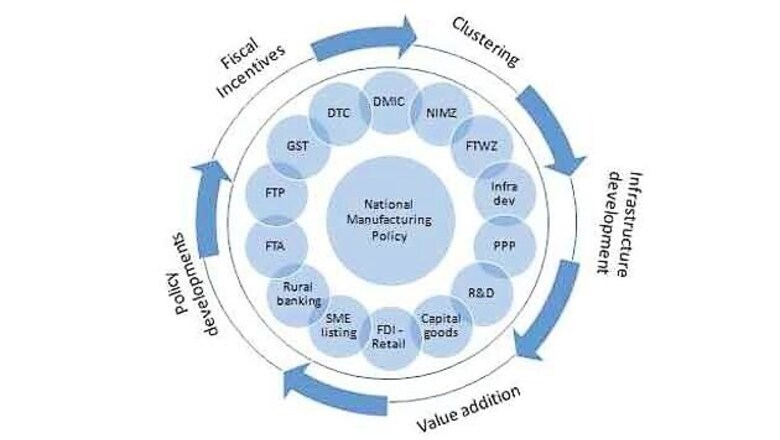
views
Revival of investor confidence is key to put economy back on a growth trajectory. The National Manufacturing Policy ("NMP") and the 'Make in India' campaign (along with the National Manufacturing Competitiveness Programme) is expected to position India as the 'business partner' for creating a 'world class manufacturing hub'.
While manufacturing sector occupies the centrestage, significance of infrastructure sector is equally relevant, especially if manufacturing sector is to garner 25 per cent share of the GDP by 2022. To achieve this, Government policies should also focus on boosting Logistics Performance Index (index for infrastructure performance), in addition to fostering the manufacturing ecosystem.
Manufacturing Ecosystem
Implementation of reforms in labour and allied factory legislations should enhance investor confidence and should be embraced by more states. Similarly, introduction of Constitution Amendment Bill, 2014 to implement GST may overhaul existing indirect tax structure removing inherent inefficiencies in the existing structure. The success however, lies in the timing and manner in which GST gets implemented.
Key expectations
Budget 2015 proposals are expected to deal with following aspects:
Policy reforms
•Legislative framework to promote, protect and commercially exploit innovative R&D.
•Guidelines to implement NMP and setting up of National Investment Manufacturing Zones by respective State Governments.
•Guidelines / roadmap to implement 'single window clearance' system for businesses engaged in infrastructure development, manufacturing and capital goods.
•Synchronise various central and state laws such as, stamp duty laws, local body licenses, and ensuring minimum lead time for implementation of policy decisions at Centre and State levels.
•Simplify and fast track implementation of land acquisition laws.
•SEZ status to shipyards to provide impetus to ship building.
•Uniform definition of 'infrastructure facility' across regulations to inter alia include ancillary activities such as the MRO segment in aviation industry, ancillary services provided for maintenance of ports / airports.
•Extend Infrastructure status to Renewable Energy (including solar energy) and Integrated Township Programme.
•Introduce low cost financing scheme for export of goods in tandem with international practice.
Direct tax
•Extend tax holiday benefits to activities involving up-gradation / extension of an 'infrastructure facility'.
•Minimise burden of dividend Distribution Tax ("DDT") and Minimum Alternate Tax ("MAT") on SEZ units / businesses eligible for profit linked deductions, including allowing reduction of investment linked deductions for MAT purpose.
•Eliminate applicability of DDT to distribution of dividend by SPVs to Infrastructure Investment Trust ("InvITs").
•Eliminate applicability of capital gains tax on exchange of shares in SPVs with units of an InvIT by the Sponsor.
•Extend investment allowance under section 32AC to companies engaged in business of infrastructure facilities.
•For companies engaged in infrastructure facilities, carry forward / set-off of business loss and unabsorbed depreciation to be allowed in case of an amalgamation or demerger.
•Increase weighted average deduction towards research activities by pharma companies and companies engaged in manufacturing technology intensive capital goods.
•Exempt income earned by universities / institutes to be set up under the 'Skill India' programme.
•Provide clarity on taxation (including MAT applicability) of consortiums with resident and non-resident players operating in infrastructure space.
To conclude, Central and State Governments' policy synchronisation, legislative and policy reforms and effective implementation of Land Acquisition Bill, seem to hold the key for Infrastructure and Manufacturing sectors. A lot depends on how effectively various policy initiatives are driven and leveraged by Central and State Governments to build a conducive environment for promoting and implementing NMP and 'Make in India' campaign.















Comments
0 comment